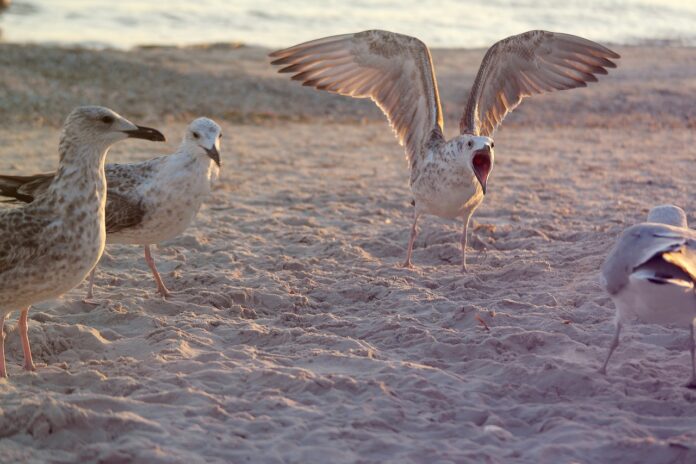Seagulls can be found all around the world—they inhabit every continent and most islands. These birds are often seen as nuisances due to their loud, harsh calls and their habit of stealing fishermen’s catches. However, it’s important to remember that humans are the ones encroaching on their territory, not the other way around.
Facts About Seagulls:
- These birds are known for stealing food and even eating the eggs of other birds. They may also attack the chicks of other gulls.
- If a predator or other danger approaches during the incubation of eggs or feeding of chicks, the entire colony will take to the air, circle the intruder, and try to chase it away by defecating on it.
- Seagulls rarely change their nesting sites, typically only doing so due to significant climate changes.
- All gulls, from the largest to the smallest species, live in colonies. These colonies can consist of tens of thousands of birds.
- The smallest member of the gull family is the little gull, weighing just around 100-150 grams. The largest is the great black-backed gull, with adults weighing over 2 kilograms.
- Seagulls inhabit areas where water meets land worldwide, and they can live far from the sea, often settling near rivers, lakes, and reservoirs.
- American herring gulls, the same species featured in Alfred Hitchcock’s film “The Birds,” can actually be aggressive. There have been numerous instances where entire flocks attacked humans who wandered onto what the birds considered their territory.
- Seagulls do not maintain social relationships between species. They occasionally eat other gulls’ eggs and chicks and even engage in cannibalism.
- Typically, a female lays 2-3 eggs. Both parents incubate the eggs for about a month. If the eggs are lost, for example, eaten by other gulls, the female quickly lays a new clutch.
- Seagulls are excellent flyers, capable of sustained flight, maneuvering expertly, changing speed, making sharp stops, diving, and executing acrobatic turns.
- Although rarely seen, seagulls can run quite fast on the ground.
- When hunting fish, seagulls can dive headfirst into the water, though they don’t dive very deep.
- Many adult gull species have distinctive marks on their bills that serve as visual cues for their chicks. The chicks peck at these marks to encourage the adults to regurgitate food.
- Seagulls can build nests out of almost anything, including grass, feathers, twigs, bits of netting, tin cans, and other trash.
- In flight, the great black-backed gull can reach speeds of up to 110 km/h. These birds have no natural predators, and their average lifespan can reach up to 23 years.
- Seagulls are not particularly shy and are often seen approaching humans to beg for pieces of bread or other food.
- There are around 100 species of gulls worldwide, divided into 22 genera by ornithologists.
- All gull species have webbed feet, which help them swim.
- Being sea birds, gulls often find themselves far from sources of fresh water. To address this, they have specialized glands on their bills that allow them to filter salt out of the water, making it drinkable. In other words, like penguins, they can drink salt water.
- These birds frequently forage at garbage dumps on the outskirts of cities. In recent years, seagulls have become the dominant scavengers, especially in winter, competing with crows for access to waste disposal sites.
- All gulls are diurnal, except for the Galápagos gull, which is nocturnal and hunts not only fish but also mollusks like small octopuses and starfish.
- These birds molt twice a year. In autumn, they undergo a full molt, and in spring, a partial molt.
- Many gull species are migratory. Colonies nesting in Europe and Asia usually migrate south to warmer climates for the winter.
- Mixed colonies are common, where gulls nest alongside herons, cormorants, wild ducks, and other birds.
